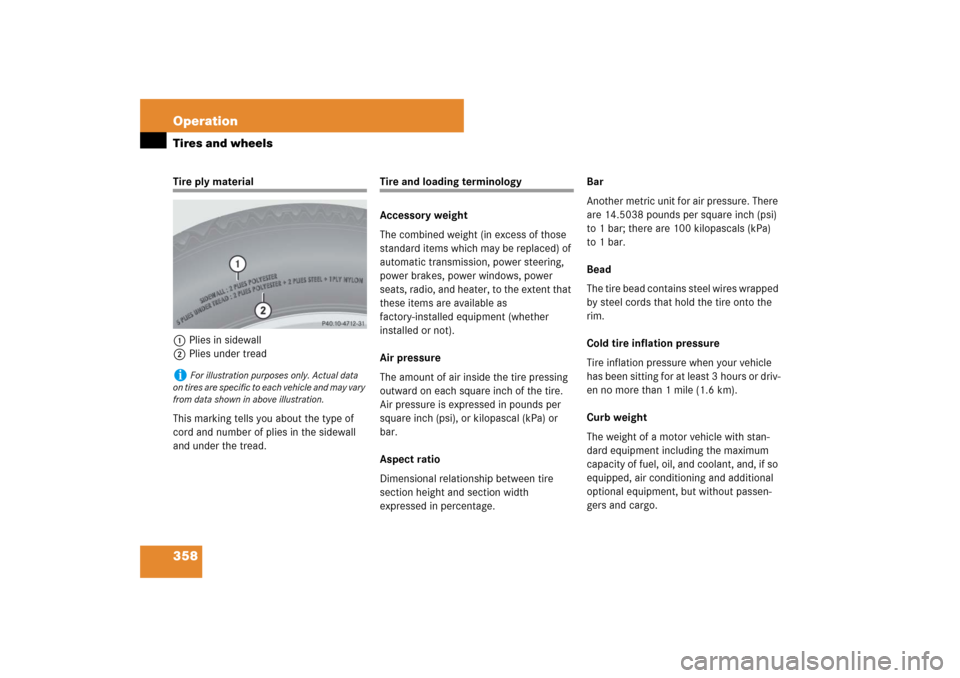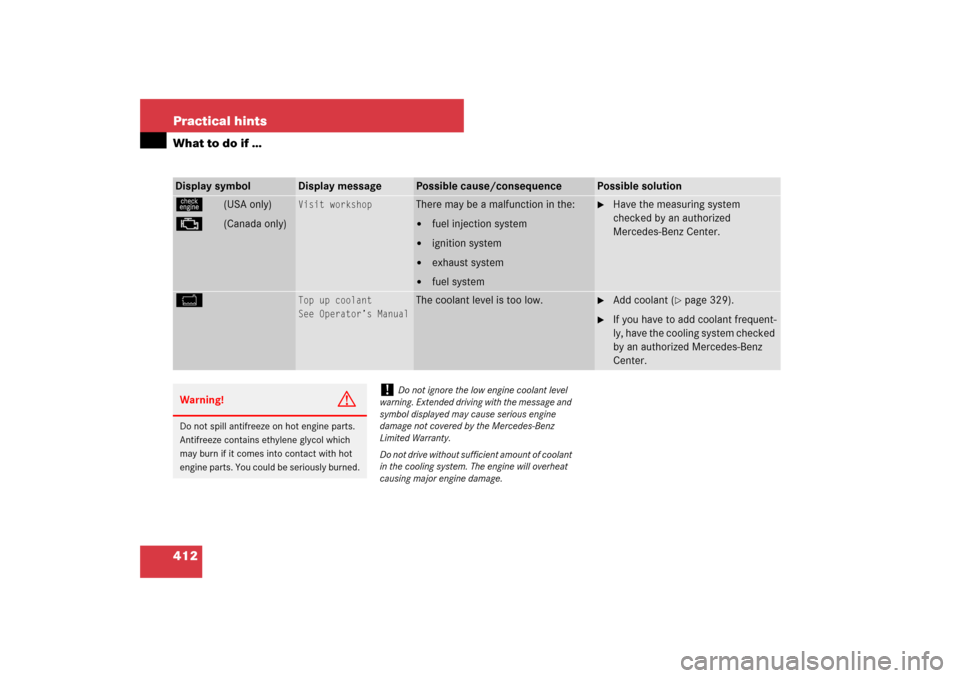Page 330 of 514

329 Operation
Engine compartment
Coolant level
The engine coolant is a mixture of water
and anticorrosion/antifreeze. To check
the coolant level, the vehicle must be
parked on level ground and the engine
must be cool.
The coolant expansion tank is located on
the driver’s side of the engine compart-
ment.
1Marking bar in the expansion tank
2Cap
3Coolant expansion tank
�
Using a rag, turn the cap2 slowly ap-
proximately one half turn counterclock-
wise to release any excess pressure.
�
Continue turning the cap2 counter-
clockwise and remove it.
The coolant level is correct if the level:�
for cold coolant: reaches marking
bar1 in the expansion tank3
�
for warm coolant: is approximately
0.6 in (1.5 cm) higher
�
Add coolant as required.
�
Replace and tighten cap2.
For more information on coolant, see the
“Technical data” section (
�page 491).
Warning!
G
In order to avoid any potentially serious
burns:�
Use extreme caution when opening the
hood if there are any signs of steam or
coolant leaking from the cooling system,
or if the coolant temperature gauge indi-
cates that the coolant is overheated.
�
Do not remove pressure cap on coolant
reservoir if coolant temperature is
above 158°F (70°C). Allow engine to
cool down before removing cap. The
coolant reservoir contains hot fluid and
is under pressure.
�
Do not spill antifreeze on hot engine
parts. Antifreeze contains ethylene gly-
col which may burn if it comes into con-
tact with hot engine parts.
�
Using a rag, slowly open the cap approx-
imately
1/2 turn to relieve excess pres-
sure. If opened immediately, scalding
hot fluid and steam will be blown out un-
der pressure.
Page 359 of 514

358 OperationTires and wheelsTire ply material
1Plies in sidewall
2Plies under tread
This marking tells you about the type of
cord and number of plies in the sidewall
and under the tread.
Tire and loading terminology
Accessory weight
The combined weight (in excess of those
standard items which may be replaced) of
automatic transmission, power steering,
power brakes, power windows, power
seats, radio, and heater, to the extent that
these items are available as
factory-installed equipment (whether
installed or not).
Air pressure
The amount of air inside the tire pressing
outward on each square inch of the tire.
Air pressure is expressed in pounds per
square inch (psi), or kilopascal (kPa) or
bar.
Aspect ratio
Dimensional relationship between tire
section height and section width
expressed in percentage.Bar
Another metric unit for air pressure. There
are 14.5038 pounds per square inch (psi)
to 1 bar; there are 100 kilopascals (kPa)
to 1 bar.
Bead
The tire bead contains steel wires wrapped
by steel cords that hold the tire onto the
rim.
Cold tire inflation pressure
Tire inflation pressure when your vehicle
has been sitting for at least 3 hours or driv-
en no more than 1 mile (1.6 km).
Curb weight
The weight of a motor vehicle with stan-
dard equipment including the maximum
capacity of fuel, oil, and coolant, and, if so
equipped, air conditioning and additional
optional equipment, but without passen-
gers and cargo.
i
For illustration purposes only. Actual data
on tires are specific to each vehicle and may vary
from data shown in above illustration.
Page 369 of 514

368 OperationVehicle careCleaning and care of vehicle
While in operation, even while parked, your
vehicle is subjected to varying external in-
fluences which, if gone unchecked, can at-
tack the paintwork as well as the vehicle
underbody and cause lasting damage.Such damage is caused not only by ex-
treme and varying climatic conditions, but
also by:
�
Air pollution
�
Road salt
�
Tar
�
Gravel and stone chipping
To avoid paint damage, you should imme-
diately remove:
�
Grease and oil
�
Fuel
�
Coolant
�
Brake fluid
�
Bird droppings
�
Insects
�
Tree resins etc.
Frequent washing reduces and/or elimi-
nates the aggressiveness and potency of
the above adverse influences.More frequent washings are necessary to
deal with unfavorable conditions:
�
near the ocean
�
in industrial areas (smoke, exhaust
emissions)
�
during winter operation
You should check your vehicle from time to
time for stone chipping or other damage.
Any damage should be repaired as soon as
possible to prevent corrosion.
In doing so, do not neglect the underbody
of the vehicle. A prerequisite for a thor-
ough check is a washing of the underbody
followed by a thorough inspection. Dam-
aged areas need to be re-undercoated.
Your vehicle has been treated at the facto-
ry with a wax-base rustproofing in the body
cavities which will last for the lifetime of
the vehicle. Post-production treatment is
neither necessary nor recommended by
Mercedes-Benz because of the possibility
of incompatibility between materials used
in the production process and others ap-
plied later.
Warning!
G
Many cleaning products can be hazardous.
Some are poisonous, others are flammable.
Always follow the instructions on the partic-
ular container. Always open your vehicle’s
doors or windows when cleaning the inside.
Never use fluids or solvents that are not de-
signed for cleaning your vehicle.
Always lock away cleaning products and
keep them out of reach of children.
Page 385 of 514

384 Practical hintsWhat to do if …Problem
Possible cause/consequence
Suggested solution
D
The red coolant temperature
warning lamp comes on when
the engine is running.
There is insufficient coolant in the reservoir.
If this warning lamp comes on frequently,
there is a leak in the cooling system.
If the coolant level is correct, the electric ra-
diator fan may be broken.
�
Immediately add coolant to prevent
engine from overheating
(�page 329).
�
Have the cooling system checked.
�
If the coolant temperature is below
248°F (120°C), you can continue
driving to the nearest authorized
Mercedes-Benz Center.
�
Avoid high engine loads (e.g. driving
uphill) and stop-and-go driving.
The red coolant temperature
warning lamp comes on while
driving and you hear a warning
sound.
The coolant temperature has exceeded
248°F (120°C).
�
Stop as soon as possible in a safe lo-
cation and allow the engine and cool-
ant to cool down.
Warning!
G
Driving when your engine is overheated can
cause some fluids which may have leaked
into the engine compartment to catch fire.
You could be seriously burned.
Steam from an overheated engine can cause
serious burns which can occur just by open-
ing the engine hood. Stay away from the en-
gine if you see or hear steam coming from it.
Turn off the engine, get out of the vehicle
and do not stand near the vehicle until the
engine has cooled down.
Page 413 of 514

412 Practical hintsWhat to do if …Display symbol
Display message
Possible cause/consequence
Possible solution
ú
(USA only)
±
(Canada only)
Visit workshop
There may be a malfunction in the:�
fuel injection system
�
ignition system
�
exhaust system
�
fuel system
�
Have the measuring system
checked by an authorized
Mercedes-Benz Center.
H
Top up coolant
See Operator’s Manual
The coolant level is too low.
�
Add coolant (
�page 329).
�
If you have to add coolant frequent-
ly, have the cooling system checked
by an authorized Mercedes-Benz
Center.
Warning!
G
Do not spill antifreeze on hot engine parts.
Antifreeze contains ethylene glycol which
may burn if it comes into contact with hot
engine parts. You could be seriously burned.
!
Do not ignore the low engine coolant level
warning. Extended driving with the message and
symbol displayed may cause serious engine
damage not covered by the Mercedes-Benz
Limited Warranty.
Do not drive without sufficient amount of coolant
in the cooling system. The engine will overheat
causing major engine damage.
Page 414 of 514

413 Practical hints
What to do if …
During severe operation conditions and
stop-and-go city traffic, the coolant tem-
perature may rise close to 248°F (120°C).
Display symbol
Display message
Possible cause/consequence
Possible solution
•
Coolant
Stop, turn engine off
The coolant is too hot.
�
Stop the vehicle in a safe location or as
soon as it is safe to do so and immediately
turn off the engine.
�
Only start the engine again after the mes-
sage disappears. You could otherwise dam-
age the engine.
�
Apply the parking brake (
�page 62).
�
Observe the coolant temperature indicator
in the instrument cluster (
�page 27).
If the temperature rises again:
�
Contact an authorized Mercedes-Benz
Center immediately.
Warning!
G
Driving when your engine is overheated can
cause some fluids which may have leaked
into the engine compartment to catch fire.
You could be seriously burned.
Steam from an overheated engine can cause
serious burns which can occur just by
opening the engine hood. Stay away from
the engine if you see or hear steam coming
from it.
Stop the vehicle in a safe location away from
other traffic. Turn off the engine, get out of
the vehicle and do not stand near the vehicle
until the engine has cooled down.
!
The engine should not be operated with the
coolant temperature above 248°F (120°C). Do-
ing so may cause serious damage which is not
covered by the Mercedes-Benz Limited
Warranty.
Page 415 of 514
414 Practical hintsWhat to do if …Display symbol
Display message
Possible cause/consequence
Possible solution
•
Coolant
Stop, turn engine off
The poly-V-belt could be broken.
�
Stop the vehicle in a safe location and im-
mediately turn off the engine.
�
Check the poly-V-belt.
If it is broken:
�
Do not continue to drive. Otherwise the en-
gine will overheat due to an inoperative wa-
ter pump which may result in damage to the
engine. Notify an authorized Mercedes-Benz
Center.
If it is intact:
�
Do not continue to drive the vehicle with
this message displayed. Doing so could re-
sult in serious engine damage that is not
covered by the Mercedes-Benz Limited
Warranty.
�
Observe the coolant temperature indicator
in the instrument cluster (
�page 27).
�
Drive immediately to the nearest authorized
Mercedes-Benz Center.
Page 416 of 514

415 Practical hints
What to do if …
Display symbol
Display message
Possible cause/consequence
Possible solution
•
The cooling fan for the coolant is malfunc-
tioning.
�
Observe the coolant temperature indicator
in the instrument cluster (
�page 27).
If the coolant temperature is under 248°F
(120°C), you may continue driving to an au-
thorized Mercedes-Benz Center.
�
Avoid placing heavy loads on the engine
(e.g. by driving uphill) as well as
stop-and-go traffic.
�
Have the fan replaced as soon as possible.
±
Display malfunction
Visit workshop
Certain electronic systems are unable to
relay information to the control system.
The following systems may have failed:�
Coolant temperature display
�
Tachometer
�
Cruise control display
�
Have the electronic systems checked by an
authorized Mercedes-Benz Center.
Engine
Service
There may be a malfunction in:�
the fuel injection system
�
the ignition system
�
the exhaust system
�
Have the engine checked as soon as possi-
ble by an authorized Mercedes-Benz Cen-
ter.